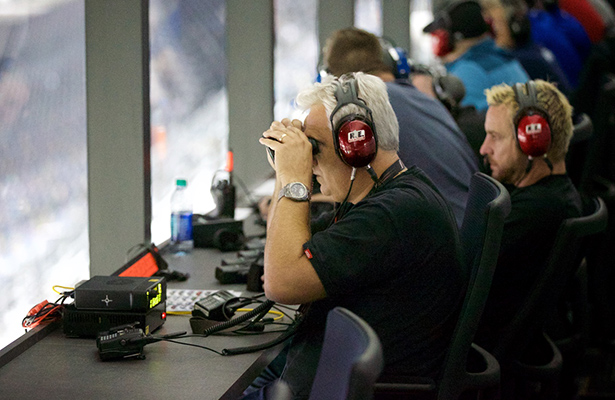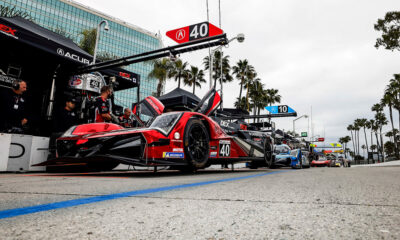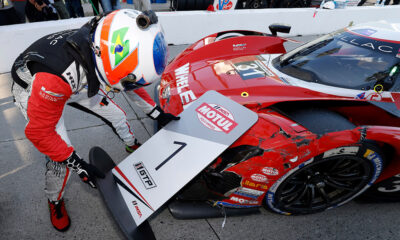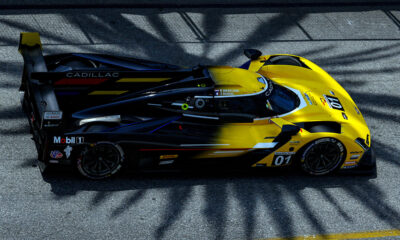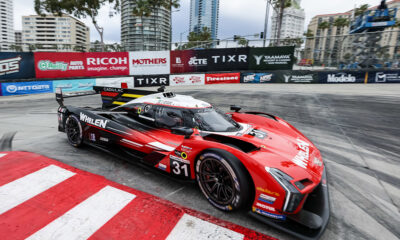CORE autosport will have two experienced eyes in the sky for this weekend’s Rolex 24, with veteran spotters Chris Monez and Stevie Reeves set to guide the team’s quartet of drivers through 24 grueling hours.
The pair bring a combined 31 years of experience as spotters, primarily in the NASCAR ranks. Reeves is currently a full-time spotter for Richard Childress Racing across all three national touring series, while Monez works for BK Racing.
Both men are former racers in their own right who found spotting as a way to stay heavily involved in motorsports after their racing careers came to an end.
While their roots are in stock car racing, both have come to appreciate the unique challenges of sports car racing, particularly the Rolex 24, where the majority of teams employ spotters for the race.
“It’s the fact that there’s four different classes and differentiating between the different classes, knowing who you’re racing, knowing who’s on the same lap with you,” Monez told Sportscar365. “The faster cars, the closing ratios, that’s kind of big.
“In NASCAR, there’s obviously fast cars and slow cars, but not this drastic. You sometimes need to be able to help your driver get passed in the right spot. It’s important so you don’t lose so much time.”
Monez and Reeves will be operating in four-hour shifts throughout the race, giving them an opportunity to rest and recuperate in between stints on the spotters’ stand.
Reeves said that a challenge for NASCAR spotters, which are common at the Rolex 24, is a lack of familiarity with cars and drivers compared to what they are used to on a stock car weekend.
“With the NASCAR thing, we’re familiar with the cars just by glancing with car numbers and paint jobs and drivers and how they react,” he said. “We’re not as familiar with all these drivers, and even if we were, you don’t know who’s in the car at the time.
“Everybody’s on a different level on this. As we’re running, we might be coming up to pass somebody and then you have a faster class coming up, then you’re three-wide and you’ve gotta deal with both.
“You’ve got to give information on what’s behind them and in front, it’s kind of like speedway racing for us at the NASCAR level, but you’re working with more variables, unknowns, than we’re used to. That’s what makes it trickier for us.”
Monez added that the unfamiliarity factor affects the drivers as well.
“The other aspect is, the drivers we’re working with aren’t necessarily used to spotters,” said Reeves. “In NASCAR, they all know what we say and what our lingo means.
“Here, we have to almost dumb-down our lingo so that everyone understands because we may be working with four different drivers throughout the race and they all have different personalities and react differently.
“You’ve got to change your spotting personality almost four times, but be consistent. You’ve got to fit the driver. It’s kind of like a dance.”
“You have to coach some people more than others,” continued Monez, who drove in the NASCAR Xfinity Series from 1994-98, as well as dabbling in IndyCar. “Some people like to hear it this way, some people like to hear it a different way.
“The first year I came [to the Rolex 24], two [drivers] had never had a spotter before and they said they didn’t want us talking at all, but by the end of the race they were like, ‘You still up there?’
“They get used to you and they rely on you for different things. It’s just a matter of getting comfortable and getting used to it. This is a 24-hour race.
“There’s plenty of time to get used to us. Once people go without spotters and then they have a spotter, they change their direction on it.”
Monez said trying to build a rapport with a team of four drivers in just a matter of days is a major challenge each year.
“When you’re doing a one-off race like this with drivers, you don’t have time to learn,” he said. “You learn as you go.
“You hope that the driver doesn’t get his feelings hurt, and you can’t get your feelings hurt as a spotter if they want something that you’re not giving them or they ask you not to say something the way you said it. You’ve got to adapt to them.”
With multiple drivers’ personalties to manage within a single four-hour shift, both men agreed that a little armchair psychology is an important part of the job.
Ultimately, they said the goal is to provide just enough information without overwhelming the drivers.
“A spotter is basically everything a driver wants to know and can’t look around to see,” said Monez. “So we tell information to a driver that he wasn’t even thinking about. Give him a new perspective.
“We paint the whole picture and let them fill it in. Not too much information, not not enough information. There’s that constant balance of talking too much and not enough.
“A good spotter, a driver won’t even really appreciate you because you’re telling him everything he needs, and it’s just automatic.”


